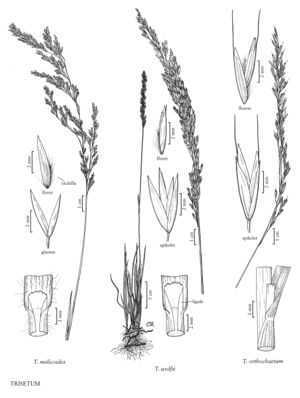Difference between revisions of "Trisetum orthochaetum"
FNA>Volume Importer |
imported>Volume Importer |
||
| (8 intermediate revisions by 2 users not shown) | |||
| Line 4: | Line 4: | ||
|publications= | |publications= | ||
|common_names=Bitterroot trisetum | |common_names=Bitterroot trisetum | ||
| + | |special_status={{Treatment/ID/Special_status | ||
| + | |code=E | ||
| + | |label=Endemic | ||
| + | }} | ||
|basionyms= | |basionyms= | ||
|synonyms= | |synonyms= | ||
| Line 17: | Line 21: | ||
-->{{Treatment/Body | -->{{Treatment/Body | ||
|distribution=Mont. | |distribution=Mont. | ||
| − | |discussion=<p>Trisetum orthochaetum is known only from Montana, in or near the edges of marshes, seeps, and creeksides, where it grows at about 1465 m. It may be a sterile hybrid between T. canescens and T. wolfii (Shelly 1987).</p> | + | |discussion=<p><i>Trisetum orthochaetum</i> is known only from Montana, in or near the edges of marshes, seeps, and creeksides, where it grows at about 1465 m. It may be a sterile hybrid between <i>T. canescens</i> and <i>T. wolfii</i> (Shelly 1987).</p> |
|tables= | |tables= | ||
|references= | |references= | ||
| Line 26: | Line 30: | ||
-->{{#Taxon: | -->{{#Taxon: | ||
name=Trisetum orthochaetum | name=Trisetum orthochaetum | ||
| − | |||
|authority=Hitchc. | |authority=Hitchc. | ||
|rank=species | |rank=species | ||
| Line 33: | Line 36: | ||
|basionyms= | |basionyms= | ||
|family=Poaceae | |family=Poaceae | ||
| + | |illustrator=Cindy Roché | ||
| + | |illustration copyright=Utah State University | ||
|distribution=Mont. | |distribution=Mont. | ||
|reference=None | |reference=None | ||
|publication title= | |publication title= | ||
|publication year= | |publication year= | ||
| − | |special status= | + | |special status=Endemic |
| − | |source xml=https:// | + | |source xml=https://bitbucket.org/aafc-mbb/fna-data-curation/src/200273ad09963decb8fc72550212de541d86569d/coarse_grained_fna_xml/V24/V24_1058.xml |
|subfamily=Poaceae subfam. Pooideae | |subfamily=Poaceae subfam. Pooideae | ||
|tribe=Poaceae tribe Poeae | |tribe=Poaceae tribe Poeae | ||
Latest revision as of 17:21, 11 May 2021
Plants perennial, with both fertile and sterile shoots; shortly rhizomatous. Culms 80-110 cm, solitary, decumbent, often anthocyanic at the base, glabrous. Leaves evenly distributed; sheaths usually glabrous; ligules 3-5 mm, truncate or rounded, erose; blades 8-20 cm long, 3-7 mm wide, flat, lax, scabrous. Panicles 13-20 cm, narrow, moderately dense, nodding, pale green, slightly tinged with purple; branches loosely ascending, naked below for 1-2 cm, the spikelets closely and evenly distributed distally. Spikelets 7-9 mm, subsessile or on pedicels to 1 cm, oblong-ovate, with 2-3(4) florets; rachilla internodes to 2 mm; rachilla hairs about 1 mm. Glumes lanceolate or oblanceolate; lower glumes about 5.5 mm long, about 1 mm wide, widest near the base, slenderly acuminate; upper glumes to 6.3 mm long, about 2 mm wide at or just above the middle, acuminate; callus hairs about 0.5 mm; lemmas 5-6.5 mm long, about 1/3 as wide as long, apices bifid, teeth shorter than 1 mm, awned, awns 4-6 mm, arising about 1 mm below the teeth, not twisted basally, straight or flexuous, exceeding the lemma apices; paleas almost equaling the lemmas; anthers minute or to 1 mm, appearing non-functional; ovaries pubescent. Caryopses to 2.5 mm, malformed. 2n = unknown.
Discussion
Trisetum orthochaetum is known only from Montana, in or near the edges of marshes, seeps, and creeksides, where it grows at about 1465 m. It may be a sterile hybrid between T. canescens and T. wolfii (Shelly 1987).
Selected References
None.
